Shengchao Qin
MFH: A Multi-faceted Heuristic Algorithm Selection Approach for Software Verification
Mar 28, 2025Abstract:Currently, many verification algorithms are available to improve the reliability of software systems. Selecting the appropriate verification algorithm typically demands domain expertise and non-trivial manpower. An automated algorithm selector is thus desired. However, existing selectors, either depend on machine-learned strategies or manually designed heuristics, encounter issues such as reliance on high-quality samples with algorithm labels and limited scalability. In this paper, an automated algorithm selection approach, namely MFH, is proposed for software verification. Our approach leverages the heuristics that verifiers producing correct results typically implement certain appropriate algorithms, and the supported algorithms by these verifiers indirectly reflect which ones are potentially applicable. Specifically, MFH embeds the code property graph (CPG) of a semantic-preserving transformed program to enhance the robustness of the prediction model. Furthermore, our approach decomposes the selection task into the sub-tasks of predicting potentially applicable algorithms and matching the most appropriate verifiers. Additionally, MFH also introduces a feedback loop on incorrect predictions to improve model prediction accuracy. We evaluate MFH on 20 verifiers and over 15,000 verification tasks. Experimental results demonstrate the effectiveness of MFH, achieving a prediction accuracy of 91.47% even without ground truth algorithm labels provided during the training phase. Moreover, the prediction accuracy decreases only by 0.84% when introducing 10 new verifiers, indicating the strong scalability of the proposed approach.
From Informal to Formal -- Incorporating and Evaluating LLMs on Natural Language Requirements to Verifiable Formal Proofs
Jan 27, 2025Abstract:The research in AI-based formal mathematical reasoning has shown an unstoppable growth trend. These studies have excelled in mathematical competitions like IMO, showing significant progress. However, these studies intertwined multiple skills simultaneously, i.e., problem-solving, reasoning, and writing formal specifications, making it hard to precisely identify the LLMs' strengths and weaknesses in each task. This paper focuses on formal verification, an immediate application scenario of formal reasoning, and decomposes it into six sub-tasks. We constructed 18k high-quality instruction-response pairs across five mainstream formal specification languages (Coq, Lean4, Dafny, ACSL, and TLA+) in six formal-verification-related tasks by distilling GPT-4o. They are split into a 14k+ fine-tuning dataset FM-alpaca and a 4k benchmark FM-Bench. We found that LLMs are good at writing proof segments when given either the code, or the detailed description of proof steps. Also, the fine-tuning brought about a nearly threefold improvement at most. Interestingly, we observed that fine-tuning with formal data also enhances mathematics, reasoning, and coding abilities. We hope our findings inspire further research. Fine-tuned models are released to facilitate subsequent studies
ICM-Assistant: Instruction-tuning Multimodal Large Language Models for Rule-based Explainable Image Content Moderation
Dec 24, 2024



Abstract:Controversial contents largely inundate the Internet, infringing various cultural norms and child protection standards. Traditional Image Content Moderation (ICM) models fall short in producing precise moderation decisions for diverse standards, while recent multimodal large language models (MLLMs), when adopted to general rule-based ICM, often produce classification and explanation results that are inconsistent with human moderators. Aiming at flexible, explainable, and accurate ICM, we design a novel rule-based dataset generation pipeline, decomposing concise human-defined rules and leveraging well-designed multi-stage prompts to enrich short explicit image annotations. Our ICM-Instruct dataset includes detailed moderation explanation and moderation Q-A pairs. Built upon it, we create our ICM-Assistant model in the framework of rule-based ICM, making it readily applicable in real practice. Our ICM-Assistant model demonstrates exceptional performance and flexibility. Specifically, it significantly outperforms existing approaches on various sources, improving both the moderation classification (36.8\% on average) and moderation explanation quality (26.6\% on average) consistently over existing MLLMs. Code/Data is available at https://github.com/zhaoyuzhi/ICM-Assistant.
MUC-driven Feature Importance Measurement and Adversarial Analysis for Random Forest
Feb 25, 2022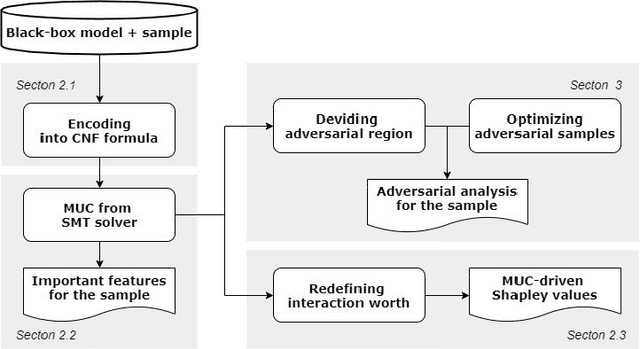


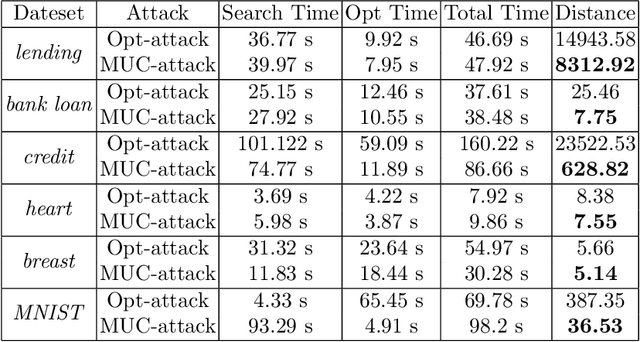
Abstract:The broad adoption of Machine Learning (ML) in security-critical fields demands the explainability of the approach. However, the research on understanding ML models, such as Random Forest (RF), is still in its infant stage. In this work, we leverage formal methods and logical reasoning to develop a novel model-specific method for explaining the prediction of RF. Our approach is centered around Minimal Unsatisfiable Cores (MUC) and provides a comprehensive solution for feature importance, covering local and global aspects, and adversarial sample analysis. Experimental results on several datasets illustrate the high quality of our feature importance measurement. We also demonstrate that our adversarial analysis outperforms the state-of-the-art method. Moreover, our method can produce a user-centered report, which helps provide recommendations in real-life applications.
Bias Field Poses a Threat to DNN-based X-Ray Recognition
Sep 19, 2020

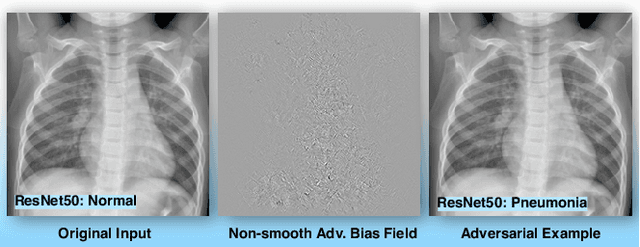

Abstract:The chest X-ray plays a key role in screening and diagnosis of many lung diseases including the COVID-19. More recently, many works construct deep neural networks (DNNs) for chest X-ray images to realize automated and efficient diagnosis of lung diseases. However, bias field caused by the improper medical image acquisition process widely exists in the chest X-ray images while the robustness of DNNs to the bias field is rarely explored, which definitely poses a threat to the X-ray-based automated diagnosis system. In this paper, we study this problem based on the recent adversarial attack and propose a brand new attack, i.e., the adversarial bias field attack where the bias field instead of the additive noise works as the adversarial perturbations for fooling the DNNs. This novel attack posts a key problem: how to locally tune the bias field to realize high attack success rate while maintaining its spatial smoothness to guarantee high realisticity. These two goals contradict each other and thus has made the attack significantly challenging. To overcome this challenge, we propose the adversarial-smooth bias field attack that can locally tune the bias field with joint smooth & adversarial constraints. As a result, the adversarial X-ray images can not only fool the DNNs effectively but also retain very high level of realisticity. We validate our method on real chest X-ray datasets with powerful DNNs, e.g., ResNet50, DenseNet121, and MobileNet, and show different properties to the state-of-the-art attacks in both image realisticity and attack transferability. Our method reveals the potential threat to the DNN-based X-ray automated diagnosis and can definitely benefit the development of bias-field-robust automated diagnosis system.
It's Raining Cats or Dogs? Adversarial Rain Attack on DNN Perception
Sep 19, 2020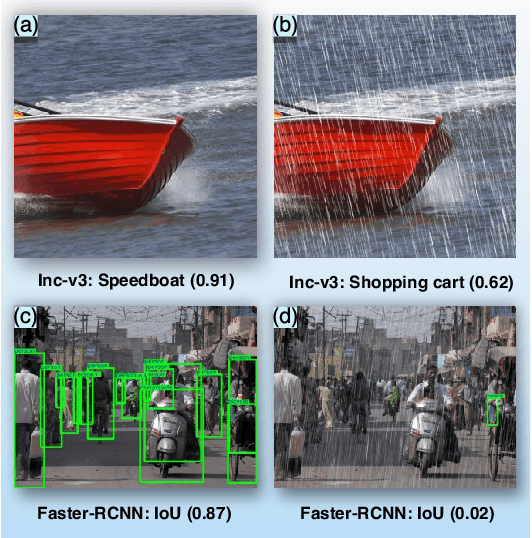
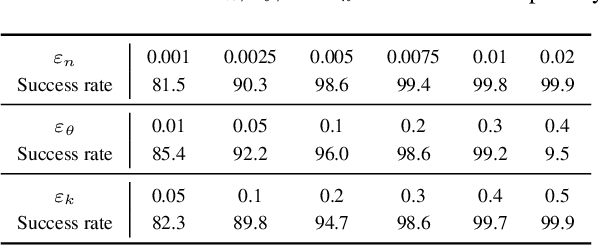

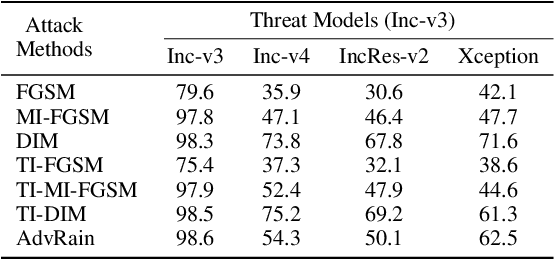
Abstract:Rain is a common phenomenon in nature and an essential factor for many deep neural network (DNN) based perception systems. Rain can often post inevitable threats that must be carefully addressed especially in the context of safety and security-sensitive scenarios (e.g., autonomous driving). Therefore, a comprehensive investigation of the potential risks of the rain to a DNN is of great importance. Unfortunately, in practice, it is often rather difficult to collect or synthesize rainy images that can represent all raining situations that possibly occur in the real world. To this end, in this paper, we start from a new perspective and propose to combine two totally different studies, i.e., rainy image synthesis and adversarial attack. We present an adversarial rain attack, with which we could simulate various rainy situations with the guidance of deployed DNNs and reveal the potential threat factors that can be brought by rain, helping to develop more rain-robust DNNs. In particular, we propose a factor-aware rain generation that simulates rain steaks according to the camera exposure process and models the learnable rain factors for adversarial attack. With this generator, we further propose the adversarial rain attack against the image classification and object detection, where the rain factors are guided by the various DNNs. As a result, it enables to comprehensively study the impacts of the rain factors to DNNs. Our largescale evaluation on three datasets, i.e., NeurIPS'17 DEV, MS COCO and KITTI, demonstrates that our synthesized rainy images can not only present visually realistic appearances, but also exhibit strong adversarial capability, which builds the foundation for further rain-robust perception studies.
Toward `verifying' a Water Treatment System
May 10, 2018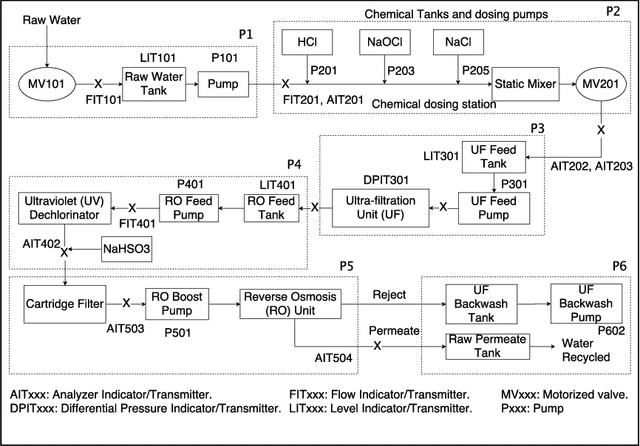
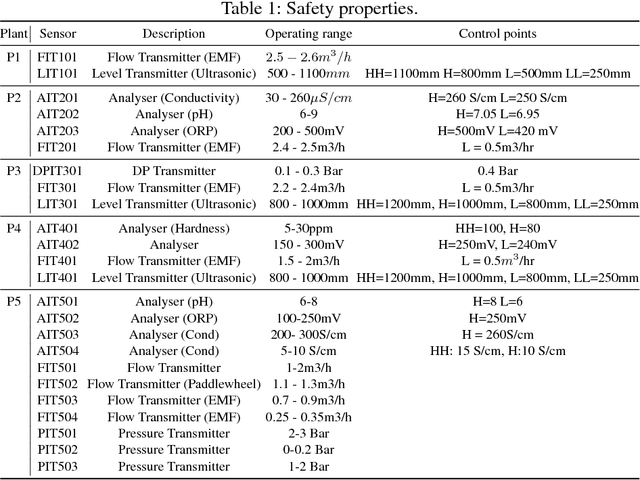

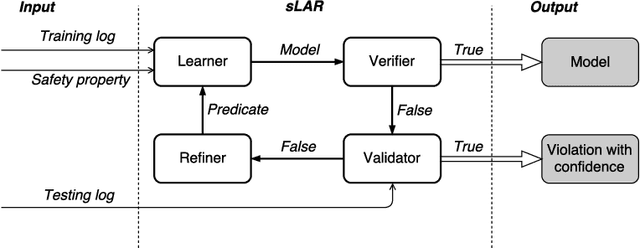
Abstract:Modeling and verifying real-world cyber-physical systems is challenging, which is especially so for complex systems where manually modeling is infeasible. In this work, we report our experience on combining model learning and abstraction refinement to analyze a challenging system, i.e., a real-world Secure Water Treatment system (SWaT). Given a set of safety requirements, the objective is to either show that the system is safe with a high probability (so that a system shutdown is rarely triggered due to safety violation) or not. As the system is too complicated to be manually modeled, we apply latest automatic model learning techniques to construct a set of Markov chains through abstraction and refinement, based on two long system execution logs (one for training and the other for testing). For each probabilistic safety property, we either report it does not hold with a certain level of probabilistic confidence, or report that it holds by showing the evidence in the form of an abstract Markov chain. The Markov chains can subsequently be implemented as runtime monitors in SWaT.
 Add to Chrome
Add to Chrome Add to Firefox
Add to Firefox Add to Edge
Add to Edge